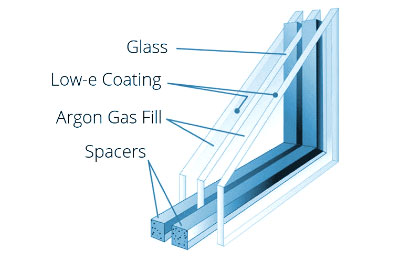Home » Blog » Argon and Krypton Gas filled Temperature Controlled Glass - Pros and Cons
Posted on : 25-06-2021 Author : Minu Sreedhar

Nowadays, energy-efficient windows are in high demand, as consumers want to reduce their power bills without reducing the comfort level.Innovations in window designs have come up with a solution to retain the thermal energy and prevent its escape via the sashes while abating the volume of solar heat penetrating inside via these windows.
This solution is of using having multiple glass panes filled with a layer of inert gas namely, argon or krypton gas. Let’s know more about these glasses.
A gas-filled glass window has an inert gas pumped inside the Insulated Glass Units (IGUs comprising of double- and triple-pane windows) for boosting its thermal efficiency. These gases are slow-moving viscous options for ensuring less convection than the normal air, reducing convective currents inside the window along with the heat transfer across the window.
As gas fills, argon and krypton are often used to fill the space between the glass panes and displace the air between them in windows. They act as a barrier to the energy that otherwise freely flows through the surrounding panes.
This results in a decreased transfer of energy due to which the HVAC system now need not have to work hard to retain a comfortable room temperature inside your home. This consequently leads to lower energy bills.
Krypton and argon gases are heavier than air and move more gradually than air. Thus, when enclosed between two glass panes, they decelerate the pace of flowing energy to prevent it from leaving the room or entering from outside.
Argon and krypton are odorless, colorless inert gases acting as insulators in glass window panes. Neither of them is toxic or poses a health risk to pets or humans in the case of gas leakage.
Most energy-efficient windows have the filling of argon gas. This gas is commonly used in double-pane windows having half an inch or more space between the panes, as the gas performs well within this width. On the other hand, krypton is pumped in triple-pane windows having the space of one-fourth or three-eight inches between the panes.
The reason is that krypton is a more cost-efficient gas when it comes to smaller spaces. Further, it is a better insulator used in such configurations.While argon is six times denser,krypton is twelve times denser than air. This makes krypton two times more effective than Argon in stopping the thermal flow from passing through a window.
Still, argon is chosen for most energy-efficient windows. This is because krypton is found in less amount in the atmosphere than argon, which increases its manufacturing cost. Thus, many manufacturers use both gases to ensure insulation effectiveness and reasonable windows’ costs.For maximum efficiency, argon is pumped in double- or triple-glazed units, while krypton is reserved for triple- or quad-glazed units.
Pros and Cons of Argon Gas Glass
The only genuine limitation of this gas it is not the most energy-efficient option. Further, the glass is likely to leak at 1% p.a. even if everything else is intact, which will eventually be replaced by moisture-laden air. Once a significant portion is leaked, condensation is seen inside the window.
Following are the benefits of using krypton gas fill in glass windows:
The only limitation of this gas fill is that it is very expensive.
Choosing between the two involves looking around your home andcomparing the purchase cost as well as energy savings. If you have an ideal climate-control system and some windows, krypton gas in a triple-paned window can be an ideal choice. However, if there are many big windows with a heating unit that works hard to retain the desired temperature, an argon-filled window with double panes can be a better asset.